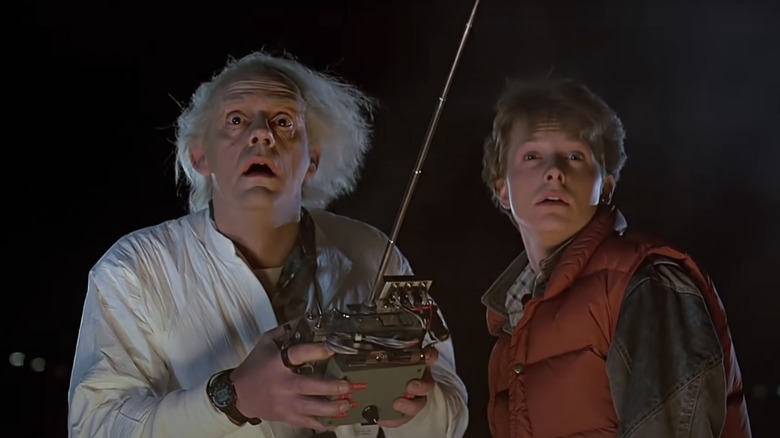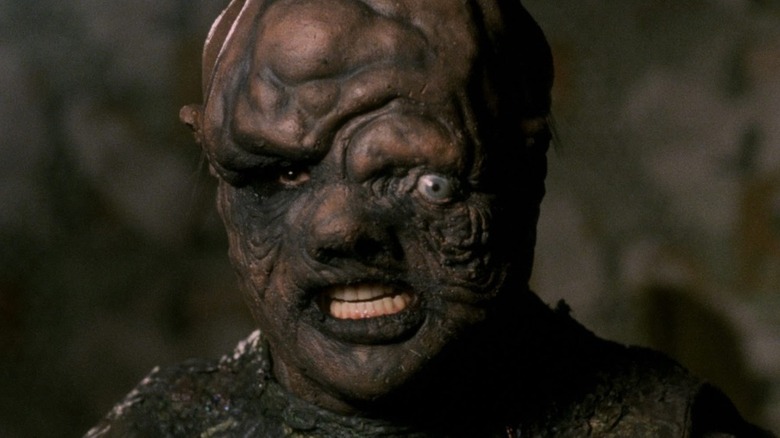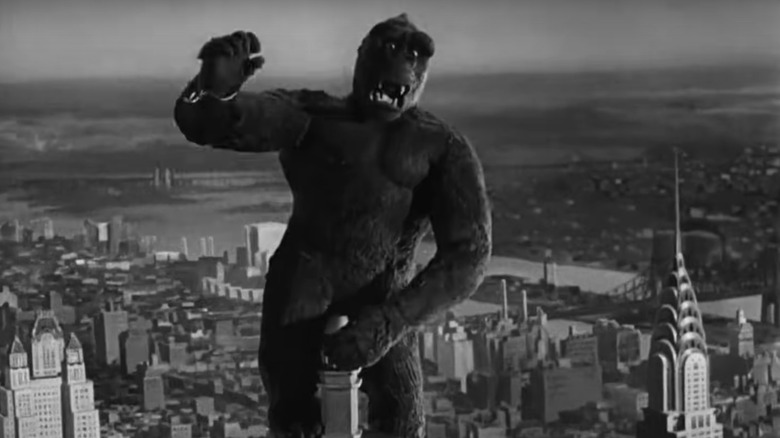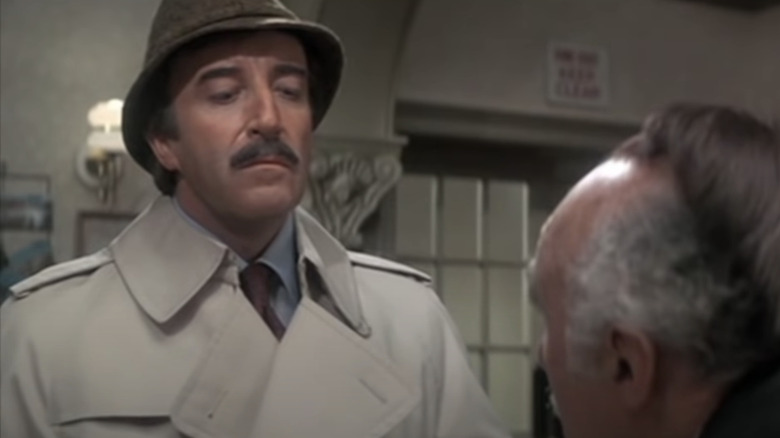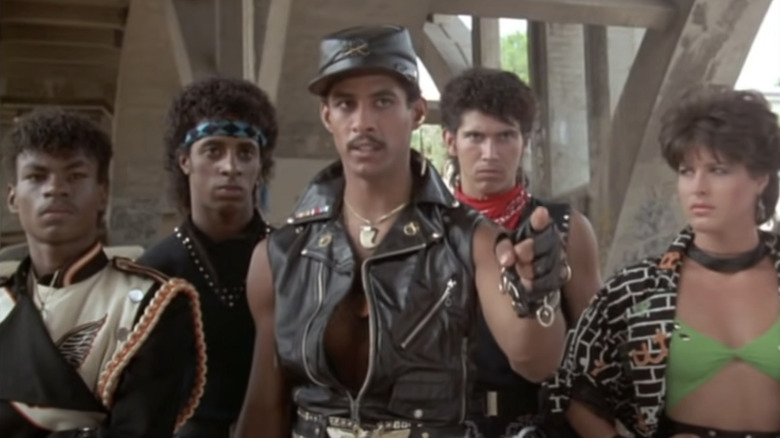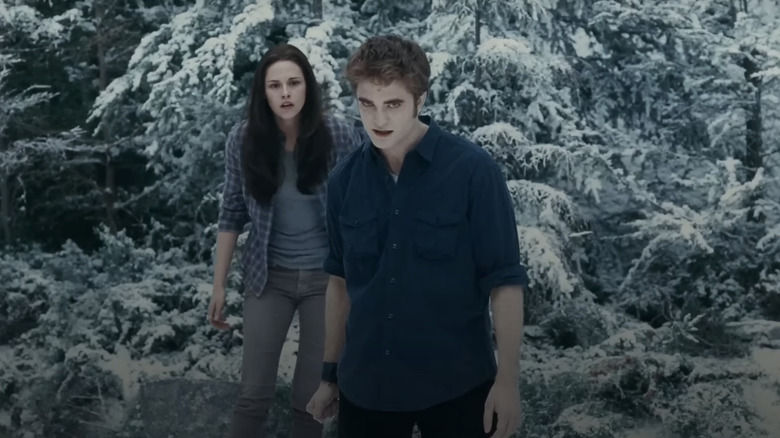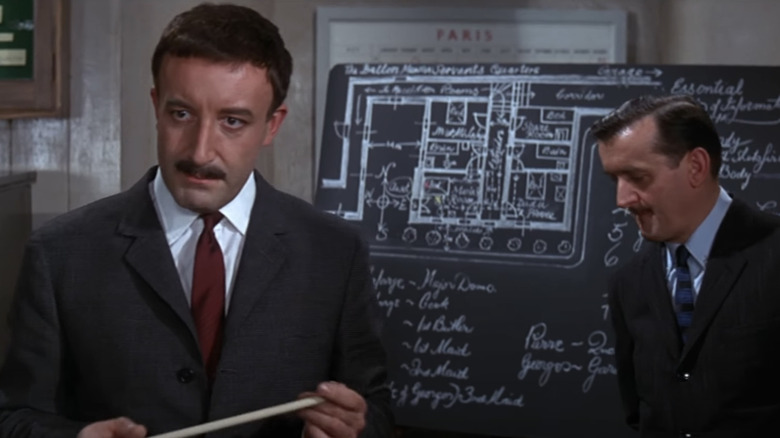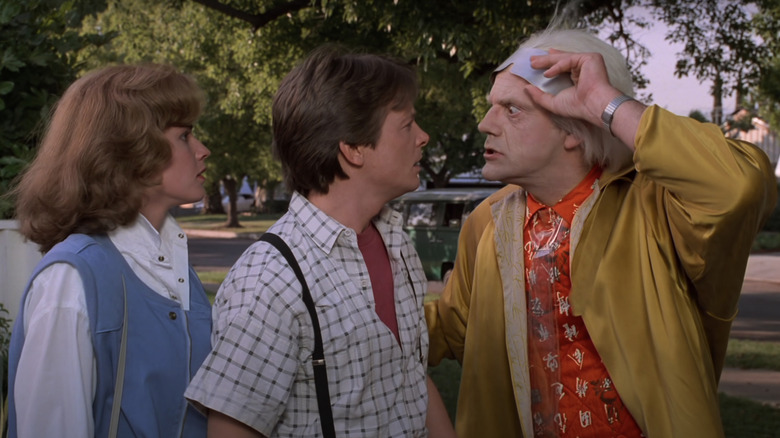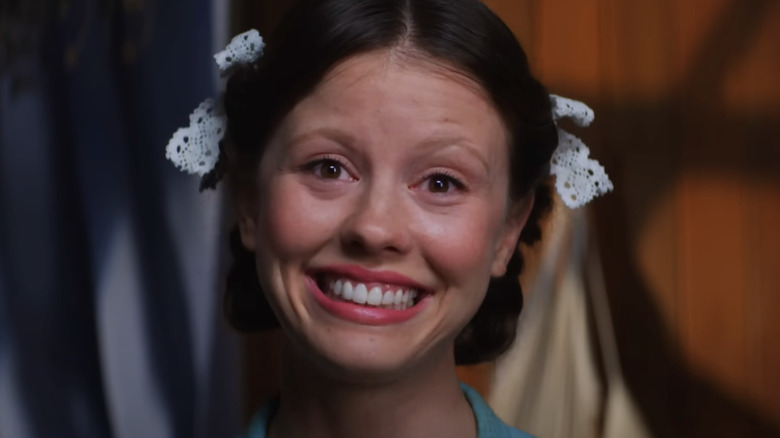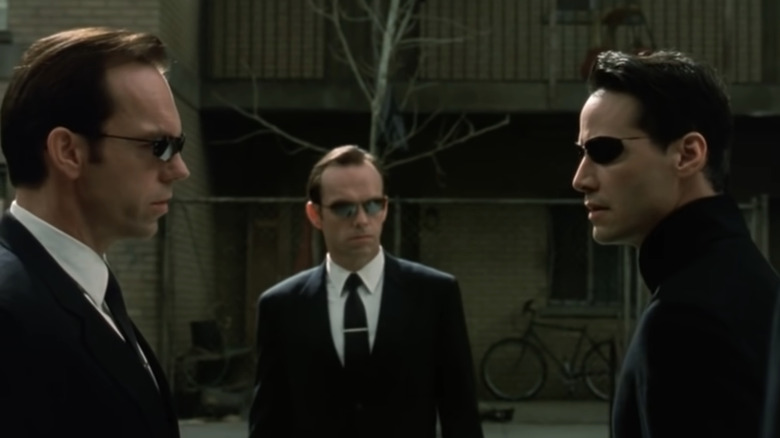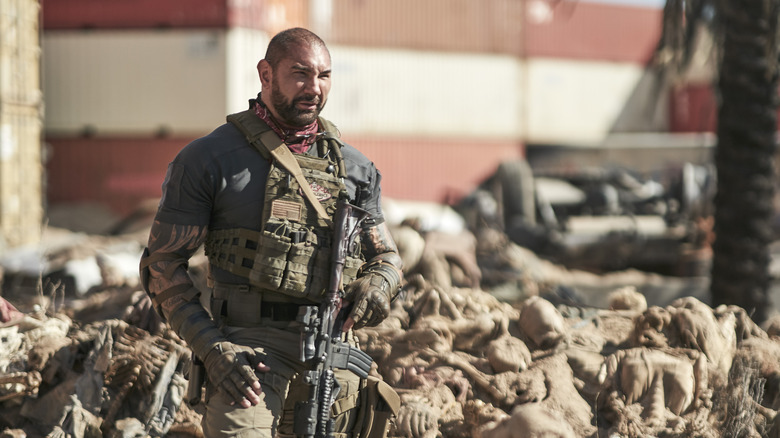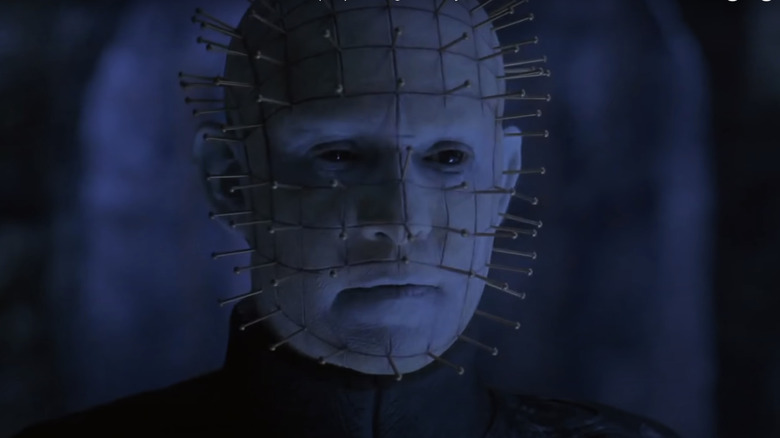Movies That Had Short Time Gaps Between The Sequel
Making a film can be an incredibly lengthy process, adding up time for development, writing, pre-production, filming, editing, marketing, and distribution. That's a big part of why some movies languish in development limbo, while others can take so long to get off the ground that they get canned. However, sequels can be much quicker to get made, especially if the predecessor was particularly successful. If a movie gets a lot of pre-release buzz, it can assure the studio of a sequel's viability even before the first installment comes out.
Why the haste? With the generally short attention span of consumers and the influx of content available for them to consume, studios do their best to immediately take advantage of an audience's interest before it wanes. Fast-tracking a sequel also helps with marketing, as it's easier to sell a follow-up when the momentum of its predecessor is still active.
Given the rapidity of producing such films, quantity is sometimes given more emphasis than quality. It's the reason why Disney and Marvel Studios have reconsidered the number of films and TV series they release for the Marvel Cinematic Universe each year, as criticisms have been raised over the quality of recent content. But which follow-up films through history got out of the gate the fastest? Let's take a look at some of the shortest gaps between movies and their sequels.
The Toxic Avenger: Part II and Part III (273 days)
In 1984, Troma Entertainment, notorious for producing low-budget independent B-movies, released "The Toxic Avenger," a campy superhero-slasher spoof. The story centers on Melvin Junko (Mitch Cohen), a timid janitor who falls into toxic waste and becomes "Toxie," a mutant monster and unconventional crimefighter in the fictional town of Tromaville, New Jersey. While the film was initially ignored after its release, it eventually garnered a cult following, naturally warranting a sequel that materialized in 1989.
However, when Troma Entertainment co-founder and "Toxic Avenger" co-director Lloyd Kaufman discovered that they had shot far more footage than what could fit in a single 90-minute film, he elected to split the sequel into two parts, subtitled "Part II" and "Part III: The Last Temptation of Toxie." Both films were released in 1989, just nine months apart, and both follow Toxie's battles against the evil corporation Apocalypse Inc.
Neither sequel could retain the fan following of the original film. "Part III" was followed by a 1991 cartoon titled "Toxic Crusaders" and a fourth film released in 2000 titled "Citizen Toxie: The Toxic Avenger IV," both of which flopped. Let's hope that the upcoming "Toxic Avenger" reboot starring Peter Dinklage can salvage the franchise from its toxic obscurity.
King Kong and Son of Kong (259 days)
Next on this list are 1933's "King Kong," the iconic film that introduced the world to the eponymous giant gorilla, and its not-so-iconic sequel, "Son of Kong," released later the same year. In spite of the Great Depression going strong when "King Kong" was released, audiences still lined up in theaters to watch the spectacle of the big ape swatting biplanes atop the Empire State Building. The film earned a whopping $90,000 gross in its opening weekend –- a record-breaking feat at the time.
Raking in an eventual total gross of over $5 million at the box office on an estimated budget of $670,000, the film immediately got the order for a sequel from RKO. "Son of Kong" was rushed to theaters just nine months after its predecessor, which became apparent to audiences. The rush job was reflected in the sequel's shorter duration of merely 69 minutes, a weaker storyline, and the lack of thrilling set pieces that "King Kong" boasted with its groundbreaking special effects. Nearly a century later, "Son of Kong" ranks among the worst "King Kong" movies, even after the numerous remakes, reboots, and Godzilla crossovers that the franchise has endured.
Trail of the Pink Panther and Curse of the Pink Panther (254 days)
Given that the "Pink Panther" series, starring Peter Sellers as Inspector Clouseau, was one of MGM's highest-grossing franchises in the 1970s, Sellers' death in 1980 put a question mark on the franchise's fate. The studio looked for ways to continue the series, even considering recasting Clouseau -– an idea rejected by series director Blake Edwards. In turn, Edwards came up with the idea to make a transitional installment that would pass the torch from Clouseau to another character.
Hence came 1982's "Trail of the Pink Panther," which followed the search for a missing Clouseau through flashback storytelling, incorporating both theatrical and deleted scenes featuring Sellers from previous "Pink Panther" movies. "Trail" failed critically and commercially, grossing only $9 million domestically in comparison to the $49 million take of "Revenge of the Pink Panther," which preceded it.
Shot simultaneously with "Trail" and released just nine months later was 1983's "Curse of the Pink Panther," which shared a similarly cursed fate. "Curse" introduced a new protagonist, Sergeant Clifton Sleigh (Ted Wass), assigned to search for the still-missing Clouseau –- who does finally appear, albeit played by Roger Moore in a parody subversion of his James Bond persona. "Curse" bombed at the box office, cementing the fact that audiences weren't interested in a "Pink Panther" franchise without Sellers. Still, MGM tried reviving the series a decade later with 1993's "Son of the Pink Panther" and a reboot series that lasted just two movies.
Breakin' and Breakin' 2: Electric Boogaloo (229 days)
Amidst the breakdancing frenzy of the 1980s, the 1984 musical film "Breakin'" danced its way to first place at the box office. The film, starring a group of then-unknown actors set in the world of breakdancing, scored a $6 million gross in its opening weekend and ultimately raked in over $36 million – a very lucrative figure for a low-budget movie and enough to quickly scrap together a sequel.
Lo and behold, "Breakin' 2: Electric Boogaloo" was released just seven months later the same year. The story follows the dance trope on a quest to prevent a community center from being demolished using the greatest weapon under their belt: breakdancing. As evidenced by that premise, the story in these films plays second fiddle to the dance numbers.
The franchise did fizzle out at the box office, with "Breakin' 2" and its little-known 1985 threequel "Rappin'" coming nowhere close to the first film's commercial success. Despite that, and each film's poor critical response, the franchise does have a legacy of helping to bring rapper and actor Ice-T to the mainstream. The second film's subtitle, "Electric Boogaloo," also spawned a widespread internet meme.
The Twilight Saga: New Moon and Eclipse (222 days)
"The Twilight Saga" became Summit Entertainment's saving grace after a string of flops plagued the studio pre-2008. After "Twilight" premiered that year, grossing $69.6 million in just its opening weekend alone and raking in a total worldwide gross of $402 million, Summit finally had a lucrative franchise on their hands, with aspirations akin to the "Harry Potter" series.
The studio had been banking on the potential of the franchise, having already acquired the rights to the next three Stephenie Meyer books right before the release of "Twilight." Summit greenlit the second film, subtitled "New Moon," immediately after the success of "Twilight," and started work on the third film, "Eclipse," well before the release of "New Moon."
Given the tight back-to-back release schedule, different directors helmed each book adaptation. While one director was busy with post-production work, the other would already be starting production on the next installment. The franchise went on to yield great returns at the box office, earning a total worldwide gross of $3.3 billion across five films.
The Pink Panther and A Shot in the Dark (188 days)
Though Inspector Clouseau is revered to be the heart and soul of the "Pink Panther" brand, the character didn't start out as such. The original 1964 film, "The Pink Panther," centers around the heist of the eponymous gem pulled off by a thief known as "the Phantom" –- played by David Niven, who received top billing. Inspector Jacques Clouseau (Peter Sellers) serves more as a foil to Niven's thief and a supporting character.
However, director Blake Edwards found his on-set improvisations with Sellers to yield much of the film's humor, resulting in Sellers' Clouseau taking the front seat over the film's heist plot. A sequel was greenlit before "The Pink Panther" was released in the United States in March 1964, and "A Shot in the Dark" opened just a little over three months later in June of the same year. The first film actually premiered in Italy in December of 1963, but even that earlier release date came just six months before the sequel arrived.
How'd they pull off making the sequel so quickly? The screenplay for "A Shot in the Dark" was adapted from the Harry Kurnitz play of the same name, which itself was adapted from the French play "L'Idiote. When Edwards was approached to take over the directorial duties of "A Shot in the Dark," he asked to bring in Sellers for the film adaptation, and the project was thus retooled as an Inspector Clouseau vehicle.
Back to the Future Part II and Part III (184 days)
1985's "Back to the Future" ends with protagonists Marty McFly and Doc Brown embarking on a new adventure, this time into the future. Though director Robert Zemeckis didn't intend to set up a sequel with such an ending, the immense success of the film –- being the highest-grossing film of the year and winning an Oscar among several other awards -– made a second film inevitable.
Given the time-traveling premise, the makers dabbled with many exciting storytelling possibilities, ultimately deciding to have two sequels that explored both Hill Valley's past and future, effectively capping off a full trilogy. As exciting as it was to follow Marty and Doc through their time-traveling hijinks across a futuristic 2015, a darker alternate 1985, and the wild west in 1885, it was equally time-consuming and exhausting to produce the second and third films.
The two sequels were filmed back-to-back, spanning 11 months. Zemeckis found himself spread thin by having to supervise the edit of "Part II" in Burbank while simultaneously shooting "Part III" in other parts of California. However, the efforts paid off. The two films went on to be great critical and financial hits, and they cemented the entire trilogy's legacy as one of the most iconic film franchises in history.
X and Pearl (182 days)
Unlike most films on this list, 2022's "X" and "Pearl" are nothing like one another, feeling as though they were helmed by two different directors given their radically different aesthetics. "X" mimics B-movie slasher hits from the 1980s with its meta plot, and "Pearl" radiates the twistedly jolly tone of classic "Golden Age" Hollywood films.
Director Ti West started developing a backstory for Pearl, the elderly baddie of "X," during the film's production. Once A24 quickly approved West's pitch for "Pearl" (much to his surprise), he began co-writing the screenplay with Mia Goth, who plays both protagonist Maxine and antagonist Pearl in "X" and returns as a younger Pearl in the eponymous prequel.
This enabled West to start filming "Pearl" immediately after wrapping "X." The crew used the same sets constructed for "X" in New Zealand, with West telling IndieWire, "I came out of quarantine and I was like, 'We're already building all of this stuff, it's COVID and we're on the one place on Earth where it's safe to make a movie. We have the whole crew from 'Avatar 2' who's on break. We should make two movies." The premise paid off, but as West said, "The miracle of A24 was that they thought this was actually a good idea."
The Matrix Reloaded and The Matrix Revolutions (174 days)
"The Matrix" became a phenomenon in 1999 for its mind-opening philosophical themes, engaging sci-fi plot, and groundbreaking action sequences that remain iconic to this day. The film teased an exciting scope for world-building and character arcs through sequels, for which the filmmakers took a page out of the "Back to the Future" franchise: finishing the story of an iconic first film with two back-to-back sequels.
However, with lead protagonist Neo (Keanu Reeves) going through a full character arc in the first film, mastering his powers and becoming the prophesized "One," the sequels focused more on the world of Zion and the Matrix. This shift led to some mind-bogglingly convoluted and heavy-handed exposition scenes that pulled many viewers out of the experience.
2003's "The Matrix Reloaded" was a major disappointment for some fans, which in turn drastically affected the box office potential of "Revolutions" just six months later in the same year. Even today, "The Matrix" is best remembered by many for the first film, rather than for the overall trilogy of films, with the sequels proving quite divisive in much the same way as the "Star Wars" prequel and sequel trilogies have been. An attempt at resurrecting the franchise with a fourth film, obviously titled "The Matrix Resurrections," pleased some but failed to endear itself to others. In the end, "The Matrix" didn't prove as franchise-worthy as Warner Bros. was probably hoping it to be, though a subset of fans still praise the sequels.
Army of the Dead and Army of Thieves (168 days)
2021 was quite a busy year for director-producer Zack Snyder. First, he released the long-awaited director's cut of "Justice League" in March, which the fandom had been campaigning for through the #ReleasetheSnyderCut movement. At the same time, he was helming "Army of the Dead," a heist-horror adventure that released in May, along with co-writing and co-producing its German-made prequel-spinoff "Army of Thieves," directed by and starring Matthias Schweighöfer, which released that October.
"Army of Thieves" was well underway during the making of "Army of the Dead" as part of Netflix and Snyder's intention of making a multimedia franchise out of the IP. Despite the middling critical reception to both films, "Army of the Dead" rose to become one of the most-watched Netflix movies ever, while "Army of Thieves" ranked at the top of Netflix's Top 10 in its first week.
Though Snyder has assured fans that an "Army of the Dead 2" is still coming, along with an anime spinoff that was greenlit with "Army of Thieves," the director currently has his hands full with another original IP that he and Netflix intend to transform into a franchise. That starts with his upcoming space-adventure epic "Rebel Moon," slated for release in December 2023.
Hellraiser: Deader and Hellraiser: Hellworld (91 days)
2005's "Deader" and "Hellworld" are the seventh and eighth films in the "Hellraiser" horror franchise, which centers on a puzzle box that acts as a gateway to a ghoulish realm occupied by the sadistic Cenobites. By then, the franchise was plagued with low-budget and poor-quality straight-to-DVD movies, given the lack of series creator Clive Barker's involvement. Barker had authored the novella "The Hellbound Heart," from which he adapted the first 1987 "Hellraiser" film as writer-director. He remained an executive producer until 2002's "Hellseeker."
Both direct-to-video 2005 sequels started out as spec scripts that were reworked into "Hellraiser" screenplays and shot back-to-back in 2002 and 2003 in Romania, helmed by "Hellraiser: Hellseeker" director Rick Bota. For reasons unknown, the films sat idle for a few years, before finally getting DVD releases a few months apart in 2005.
The only noteworthy aspect of "Hellworld" is that it features a young and then-unknown Henry Cavill, eight years before he became Superman in 2013's "Man of Steel." Both films are ranked among the worst "Hellraiser" movies and were the last to feature Doug Bradley as Pinhead, who had portrayed the antagonist in every film in the series since the 1987 original. After two more shoddily produced entries, the franchise received a proper reboot in 2022, with Hulu's "Hellraiser" seeing Barker return to the franchise as co-producer.
